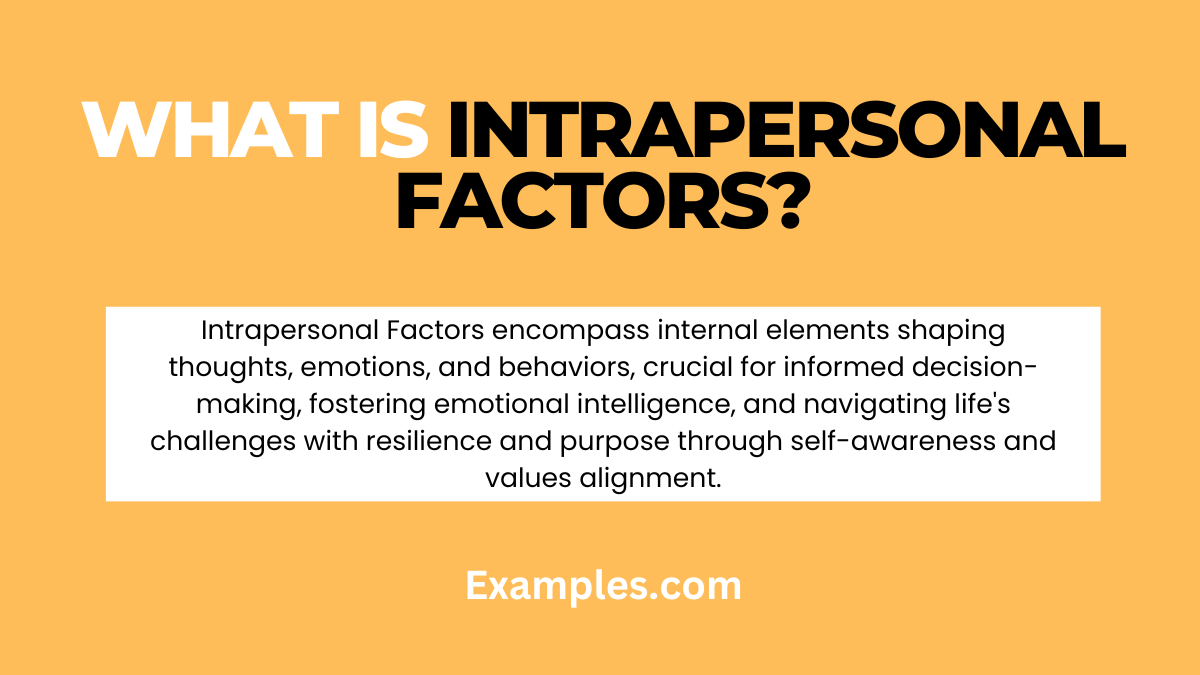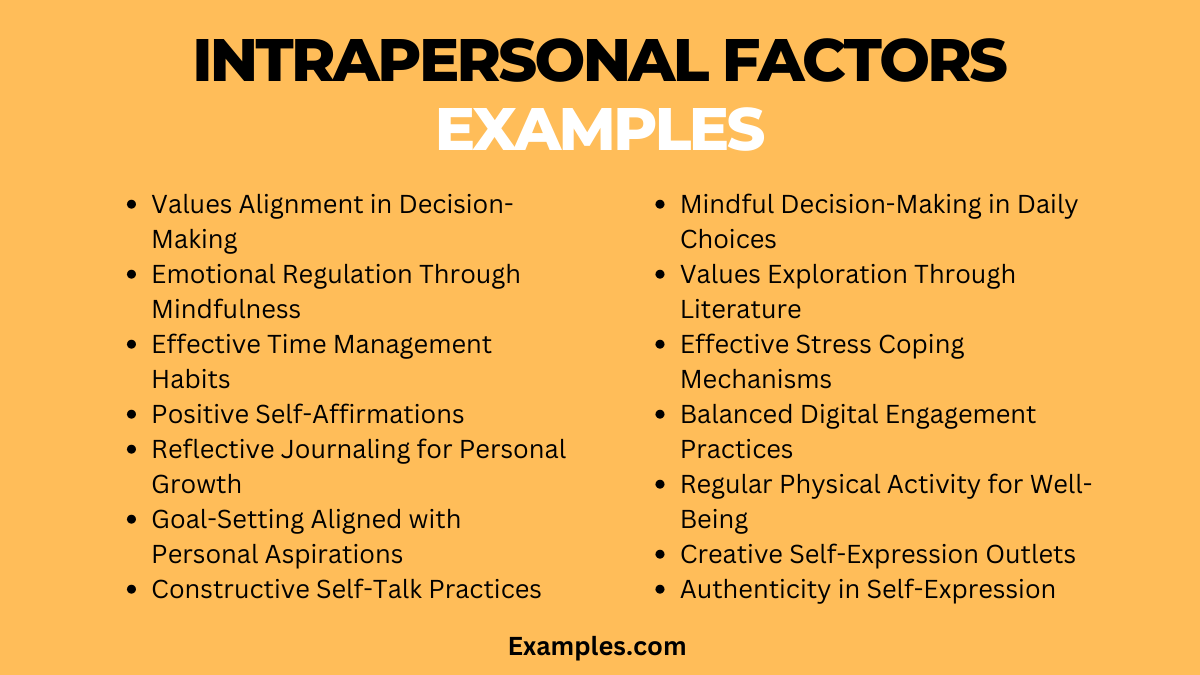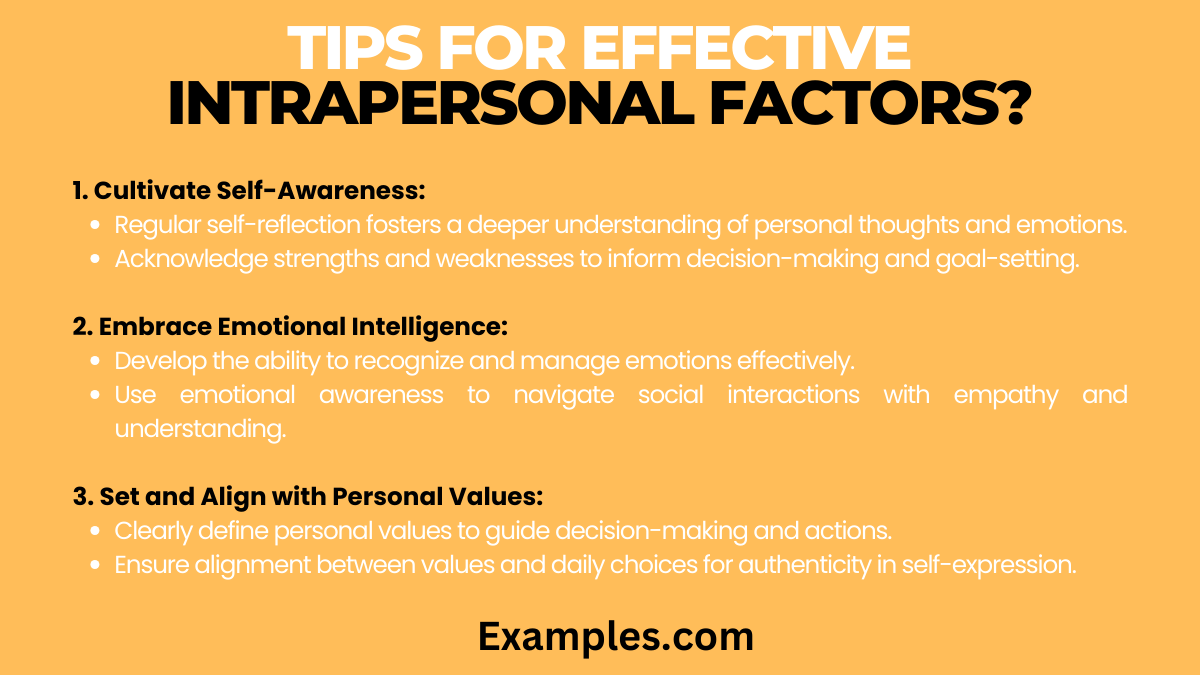24+ Intrapersonal Factors Examples
Embark on a transformative journey with our comprehensive guide to Intrapersonal Factors. Delve into unique examples and practical tips that go beyond traditional self-help. This guide goes deep, emphasizing the importance of effective self-communication examples within intrapersonal realms. Explore the art of nurturing personal strengths, fostering emotional intelligence, and unleashing the full potential of your intrapersonal abilities for a more resilient and self-aware existence. This is your roadmap to mastering the intricacies of self-connection and empowerment. Communication examples await your exploration.
What is Intrapersonal Factors?
 Intrapersonal Factors refer to internal elements influencing an individual’s thoughts, emotions, and behaviors. These factors include self-awareness, personal values, motivations, and cognitive processes. Understanding intrapersonal factors is crucial for navigating one’s inner world, making informed decisions, and fostering emotional intelligence. By recognizing and managing these internal aspects, individuals can enhance self-communication, promote personal growth, and navigate life’s challenges with resilience and purpose.
Intrapersonal Factors refer to internal elements influencing an individual’s thoughts, emotions, and behaviors. These factors include self-awareness, personal values, motivations, and cognitive processes. Understanding intrapersonal factors is crucial for navigating one’s inner world, making informed decisions, and fostering emotional intelligence. By recognizing and managing these internal aspects, individuals can enhance self-communication, promote personal growth, and navigate life’s challenges with resilience and purpose.
What is the Best Example of Intrapersonal Factors?
 One exemplary illustration of intrapersonal factors involves values alignment in decision-making. This showcases an individual’s capacity to harmonize choices with their deeply held personal values. Through introspection, individuals assess motivations, strengths, and limitations, ensuring decisions resonate with their core principles. This example underscores how understanding and incorporating intrapersonal factors, like values, empowers individuals to make authentic, purpose-driven decisions, fostering personal growth and a more meaningful life journey.
One exemplary illustration of intrapersonal factors involves values alignment in decision-making. This showcases an individual’s capacity to harmonize choices with their deeply held personal values. Through introspection, individuals assess motivations, strengths, and limitations, ensuring decisions resonate with their core principles. This example underscores how understanding and incorporating intrapersonal factors, like values, empowers individuals to make authentic, purpose-driven decisions, fostering personal growth and a more meaningful life journey.
25 Intrapersonal Factors Examples
 Explore 25 diverse examples of Intrapersonal Factors, each contributing to the tapestry of self-awareness and personal growth. This guide provides insights into understanding and leveraging these factors for effective self-communication.
Explore 25 diverse examples of Intrapersonal Factors, each contributing to the tapestry of self-awareness and personal growth. This guide provides insights into understanding and leveraging these factors for effective self-communication.
- Values Alignment in Decision-Making: Align choices with personal values for authentic decisions. Example: “I chose my career path based on my passion for environmental sustainability.”
- Emotional Regulation Through Mindfulness: Cultivate emotional intelligence through mindful practices.
Example: “Practicing deep breathing helps me manage stress in challenging situations.” - Effective Time Management Habits: Organize priorities for balanced living and reduced stress.
Example: “Creating a daily schedule ensures I allocate time for work, leisure, and self-care.” - Positive Self-Affirmations: Foster self-esteem with daily positive affirmations.
Example: “I affirm my worth and capabilities, promoting a positive self-image.” - Reflective Journaling for Personal Growth: Chronicle experiences for insights and personal development.
Example: “Journaling helps me gain clarity on my thoughts and emotions.” - Goal-Setting Aligned with Personal Aspirations: Set meaningful goals in alignment with individual aspirations.
Example: “I aim for career milestones that resonate with my long-term vision.” - Constructive Self-Talk Practices: Develop a habit of constructive self-talk for improved self-perception. Example: “In challenging times, I reassure myself with affirming statements.”
- Mindful Decision-Making in Daily Choices: Apply mindfulness to everyday decisions for better outcomes.
Example: “Choosing healthier meal options aligns with my goal for overall well-being.” - Values Exploration Through Literature: Analyze literary characters to explore personal values.
Example: “Identifying with a character’s resilience helps me understand my own strengths.” - Effective Stress Coping Mechanisms: Employ stress coping techniques like exercise or creative activities. Example: “Painting serves as a therapeutic outlet during stressful periods.”
- Balanced Digital Engagement Practices: Establish healthy relationships with technology for mental well-being.
Example: “Limiting screen time allows me to focus on meaningful offline activities.” - Regular Physical Activity for Well-Being: Prioritize exercise for physical and mental health benefits. Example: “Daily walks boost my energy and contribute to overall well-being.”
- Empathy and Compassion Towards Oneself: Practice self-empathy in challenging situations.
Example: “Understanding my struggles with kindness enhances my resilience.” - Mindful Eating Habits for Nutritional Well-Being: Cultivate awareness during meals for a healthy relationship with food.
Example: “Savoring each bite enhances my connection to nourishment.” - Setting and Maintaining Boundaries: Establish and communicate personal boundaries for balanced relationships.
Example: “Clearly expressing limits ensures healthy interactions.” - Creative Self-Expression Outlets: Engage in creative pursuits for emotional expression.
Example: “Writing poetry allows me to articulate my emotions authentically.” - Authenticity in Self-Expression: Embrace authenticity in communication for genuine connections. Example: “Expressing my true feelings fosters deeper connections with others.”
- Gratitude Practices for Positivity: Cultivate gratitude to focus on life’s positive aspects.
Example: “Daily gratitude journaling shifts my perspective toward appreciation.” - Setting Realistic Expectations for Self: Establish achievable goals to avoid undue pressure.
Example: “Acknowledging my limits allows for realistic and sustainable personal expectations.” - Effective Problem-Solving Skills: Develop a solution-oriented mindset for addressing challenges. Example: “Breaking down complex problems into manageable steps enhances my problem-solving abilities.”
- Regular Mindfulness Meditation Sessions: Incorporate mindfulness into daily routines for enhanced focus.
Example: “Morning meditation sets a positive tone for the day.” - Balanced Social Engagement Practices: Manage social interactions to maintain energy and well-being. Example: “Balancing social events with quiet time preserves my emotional resources.”
- Constructive Handling of Setbacks: Cultivate resilience by viewing setbacks as opportunities for growth. Example: “Learning from failures enhances my personal and professional resilience.”
- Effective Communication of Personal Boundaries: Clearly communicate boundaries to foster healthy relationships.
Example: “Expressing my need for personal space ensures balanced relationships.” - Mindful Reflection on Personal Achievements: Celebrate accomplishments through reflective introspection.
Example: “Acknowledging my achievements fuels motivation for future endeavors.”
By exploring these examples, individuals can gain valuable insights into their intrapersonal factors, fostering self-awareness and empowering effective self-communication.
Intrapersonal Factors for Students Examples
Explore how intrapersonal factors shape students’ experiences, aiding in academic success and personal development. Delve into five crucial examples, showcasing the influence of self-awareness, motivation, and emotional intelligence on the student journey.
- Effective Time Management Skills:
Example: “Balancing study sessions with breaks enhances focus and productivity, fostering a healthy study routine.” - Resilience in Facing Academic Challenges:
Example: “Embracing setbacks as learning opportunities builds resilience, ensuring continuous academic growth.” - Goal-Setting for Future Success:
Example: “Setting academic goals aligns studies with personal aspirations, fostering a sense of purpose.” - Adaptive Stress Coping Mechanisms:
Example: “Practicing mindfulness during exams alleviates stress, promoting mental well-being for optimal performance.” - Reflective Learning Through Journaling:
Example: “Journaling reflections on coursework aids self-discovery, facilitating continuous academic improvement.”
Intrapersonal Factors for Business Examples
Explore how intrapersonal factors impact professional success, highlighting essential elements for thriving in the business world. Discover five key examples, emphasizing self-awareness, effective communication, and resilience in the corporate realm.
- Leadership Self-Efficacy:
Example: “Believing in one’s leadership abilities fosters confidence, driving effective decision-making and team collaboration.” - Negotiation Skills Development:
Example: “Understanding personal negotiation style enhances communication, fostering successful business transactions.” - Emotional Intelligence in Team Dynamics:
Example: “Navigating diverse team dynamics with emotional intelligence promotes collaboration and workplace harmony.” - Adaptability to Change:
Example: “Embracing change as an opportunity for growth enhances professional agility, ensuring relevance in dynamic business environments.” - Effective Conflict Resolution Practices:
Example: “Applying empathetic conflict resolution techniques cultivates a positive work environment, fostering cohesive team relationships.”
Intrapersonal Factors of Alcohol Examples
Explore intrapersonal factors influencing alcohol consumption, shedding light on self-awareness and responsible drinking. Examine five essential examples, emphasizing decision-making, self-regulation, and awareness of personal limits.
- Mindful Drinking Habits:
Example: “Savoring each sip mindfully encourages responsible alcohol consumption, fostering a healthier relationship with drinking.” - Values Alignment in Social Settings:
Example: “Aligning alcohol choices with personal values ensures responsible behavior, even in social gatherings.” - Self-Reflection on Drinking Patterns:
Example: “Regularly assessing alcohol consumption aids self-discovery, promoting conscious choices for a balanced lifestyle.” - Setting and Adhering to Personal Limits:
Example: “Establishing alcohol consumption limits safeguards well-being, ensuring responsible and moderate drinking.” - Navigating Social Pressure with Confidence:
Example: “Communicating personal boundaries in social settings empowers responsible alcohol choices, fostering peer understanding.”
What intrapersonal factors affect communication?
Intrapersonal factors play a pivotal role in shaping effective communication. Understanding these internal elements is crucial for navigating conversations and building meaningful connections. Explore the key intrapersonal factors influencing communication:
- Self-Perception: How individuals perceive themselves impacts how they present ideas and interact with others.
- Emotional Intelligence: Recognizing and managing emotions contributes to empathetic and effective communication.
- Communication Apprehension: Anxiety or confidence levels influence the willingness to express thoughts openly.
- Personal Values and Beliefs: Individual values shape communication choices and preferences.
- Motivations and Goals: The purpose behind communication and personal objectives impact message delivery.
- Cognitive Processes: Thinking patterns influence information processing and expression of ideas.
- Listening Skills: Effective intrapersonal factors enhance active listening and comprehension.
What is the difference between interpersonal and intrapersonal factors?
Certainly! Here’s a comparison in table format between interpersonal and intrapersonal factors:
| Factor Type | Interpersonal Factors | Intrapersonal Factors |
|---|---|---|
| Definition | Factors that involve interactions between individuals. | Factors that pertain to an individual’s internal processes. |
| Focus | Focus on relationships, communication, and interactions. | Focus on self-awareness, personal thoughts, and emotions. |
| Examples | 1. Communication skills. | 1. Self-perception. |
| 2. Empathy. | 2. Emotional intelligence. | |
| 3. Conflict resolution. | 3. Motivations and goals. | |
| 4. Listening skills. | 4. Personal values and beliefs. | |
| Impact on Others | Directly influences how individuals relate to and communicate with others. | Indirectly affects external interactions through self-awareness and emotional regulation. |
| Communication Type | Focuses on external communication in social contexts. | Primarily concerns internal dialogue and self-expression. |
| Examples in Context | 1. Two colleagues resolving a conflict. | 1. A person reflecting on personal goals and motivations. |
| 2. Friends engaging in a conversation. | 2. An individual managing and regulating their emotions. |
Understanding the distinction between interpersonal and intrapersonal factors is essential for navigating both external relationships and internal self-awareness.
Tips for Effective Intrapersonal Factors?

Intrapersonal factors play a crucial role in personal development and effective communication. Here’s a guide to enhancing and leveraging these internal elements for a more fulfilling life:
- Cultivate Self-Awareness:
- Regular self-reflection fosters a deeper understanding of personal thoughts and emotions.
- Acknowledge strengths and weaknesses to inform decision-making and goal-setting.
- Embrace Emotional Intelligence:
- Develop the ability to recognize and manage emotions effectively.
- Use emotional awareness to navigate social interactions with empathy and understanding.
- Set and Align with Personal Values:
- Clearly define personal values to guide decision-making and actions.
- Ensure alignment between values and daily choices for authenticity in self-expression.
- Establish Clear Personal Boundaries:
- Communicate and uphold boundaries to maintain well-being in relationships.
- Understand and respect personal limits to foster healthy interactions.
- Goal-Setting for Personal Growth:
- Set realistic and achievable goals aligned with individual aspirations.
- Break down larger goals into smaller, manageable steps for continuous progress.
In conclusion, understanding and nurturing intrapersonal factors are essential for personal growth and effective communication. By cultivating self-awareness, embracing emotional intelligence, and aligning with personal values, individuals can navigate life’s complexities with resilience. These intrapersonal insights serve as guiding lights, empowering individuals to make informed decisions, build meaningful connections, and embark on a fulfilling journey of self-discovery.



